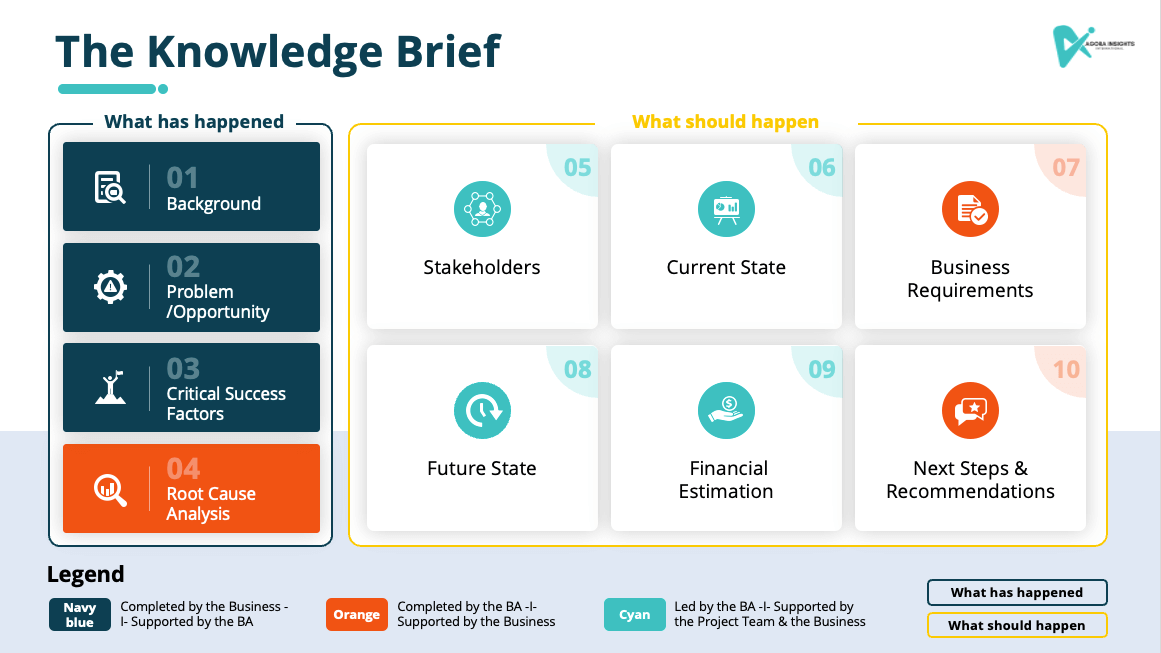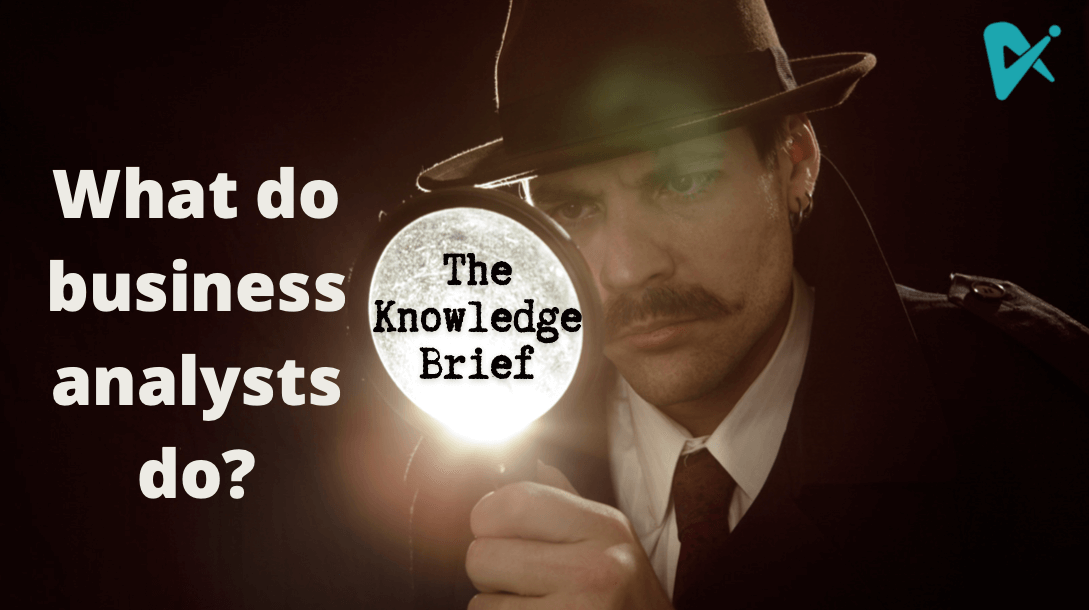Introduction to The Knowledge Brief
While having a set of requirements is essential to the project, we also want stakeholders to understand why the change exists, why the needs are important, and how this information may help them so that they can make great decisions. Without a firm fundamental understanding of the "why" and "what" we are doing in a change project, we risk not reaching the desired result. Statistics show that, despite the best intentions, projects continue to fail, and one of the leading causes is inadequate requirements. Therefore, the purpose of The Knowledge Brief is to present the structure of strategic and tactical steps behind the proposed change strategy or action to solve a need within a business thus providing better clarity to all stakeholders.
What do business analysts do?
Have you ever been in a position where you were going out for the evening and meeting new people? Eventually, the conversation will turn to a professional topic, and you will mention that you are a "Business Analyst." This all appears harmless enough, but we all know that ultimately you'll be asked, "What do business analysts do?" It will be challenging and tricky to explain. This raises some challenges...
- How would we communicate what we do to individuals in a straightforward manner?
- How can we understand the roles ourselves?
- How do we describe what we have done when we change jobs or industries?
- How do we genuinely comprehend what we are expected to perform?
- What does a business analyst do?
- And why is it important?
I believe it is critical to recognise that there is a structure and foundation within which we operate as business analysts. It's also vital to understand that it's pretty predictable and straightforward. As I introduce you to The Knowledge Brief, I'll use an investigative journalist metaphor to explain the role of a business analyst and what we do.
Welcome to The Knowledge Brief

So, what exactly is the knowledge brief? This is, for all intents and purposes, simply a tool. As a result, it's not overly fancy or complicated. It could be described as a simplified business case or business requirements document template for business analysts. In the past, business analysts were frequently required to create these large documents that in many cases stakeholder wouldn't read. And this is a significant challenge because, as a business analyst, you want others to value what you do. So, while having a set of requirements is critical to the project, we also want people to understand why the project exists, why the requirements matter, and the value of this information.
The goal is to keep things as simple as possible. And the reason we keep it simple is because we know we work with numerous stakeholders who have different information needs. We don't only work with one type of stakeholder. We work with C-level executives, end users, and customers, as well as sponsors, project managers, and business architects. And we collaborate with a diverse group of people to not only record requirements, but also to truly comprehend and analyse what these changes might be. So I wanted The Knowledge Brief to be simple but informative. As BAs, our intention is to present the stakeholders with clarity, not certainty, but clarity. And clarity is basically about ensuring that you have what you need to make good decisions. It's simple. It's self-evident.
When we talk about requirements, we often talk about how it needs to be atomic, concise, clear. As a result, every aspect of The Knowledge Brief must be tailored to these principles. It's almost like completing a whole set of requirements while also doing your background statement and various other components in your Knowledge Brief, which we'll explore soon, using similar principles.
As previously stated, The Knowledge Brief is merely a tool for condensing structured information while remaining true to the value of the information and delivering it to the audience in a specified manner. Again, you do not have to provide everything within The Knowledge Brief; it is up to you and the stakeholders to determine the depth of information. It's formatted as a dashboard that can be printed or used as a presentation. For instance, instead of a paper, we can present numerous slides or just one, depending on your audience.
Meet your investigative journalist

Now, consider yourself an investigative journalist, and I frequently say this about business analysts: what you're actually doing is gathering information from multiple sources, investigating and evaluating it, and compiling it into a package. And so, effectively, what you're doing here is crafting a story out of a collection of facts. As a result, The Knowledge Brief becomes your instrument for conducting research, gathering crucial information, and presenting your findings to your audience in a clear and organised manner.
In our 12-part blog series, we will explore the tactics required in a change in an open, understandable manner. So you can experiment by putting together your own Knowledge Brief. This is intended to assist you as a BA; it is not intended to dictate exactly how you should do it, but it does help answer the question. "What do business analysts do?" The Knowledge Brief has the potential to spark insight into genuine business change or transformation, and it is always contextual. So what you're attempting to do here is establish context, basic understanding, clarity on what the project is, and conciseness so that anyone you talk to understands the value of the project at hand. So, welcome to The Knowledge Brief. I am delighted that you have viewed this brief summary (and considered the role of an investigative journalist) as you continue through the various sections of your Knowledge Brief. Happy Learning!
Key learnings
- What do business analysts do?
- What exactly is the knowledge brief?
- While having a set of requirements is critical to the project, we also want people to understand why the project exists, why the requirements matter, and explain the value of these requirements.
- The Knowledge Brief is merely a tool for condensing information while remaining true to the value of the information and delivering it to the audience in a relevant manner.
- As a result, the knowledge brief becomes your instrument for conducting research, gathering crucial information, and presenting your findings to your audience in a clear and organised manner.
I am delighted that you have viewed this brief summary and encourage you to continue through the various sections of your Knowledge Brief.
Summary
The purpose of The Knowledge Brief is to present the strategic and tactical steps behind the proposed change strategy or action to solve a need within a business, thus providing better clarity to all stakeholders. Therefore, our goal as BAs is to provide clarity to stakeholders. Clarity is about having just what you need to make good decisions and move your change project forward. The Knowledge Brief is a mechanism to achieve this by condensing information while maintaining the information quality. It's simple and self-explanatory. It's a dashboard that may be printed or used as a presentation. In our 12-part series, we will look at The Knowledge Brief and how it might help you achieve better outcomes on you change projects.
To download a free copy of The Knowledge Brief email us support@agorainsights.com
© The Knowledge Brief is a product of Agora Insights Ltd. All rights are reserved.
Post sponsored by Agora Insights Ltd

Post a Comment